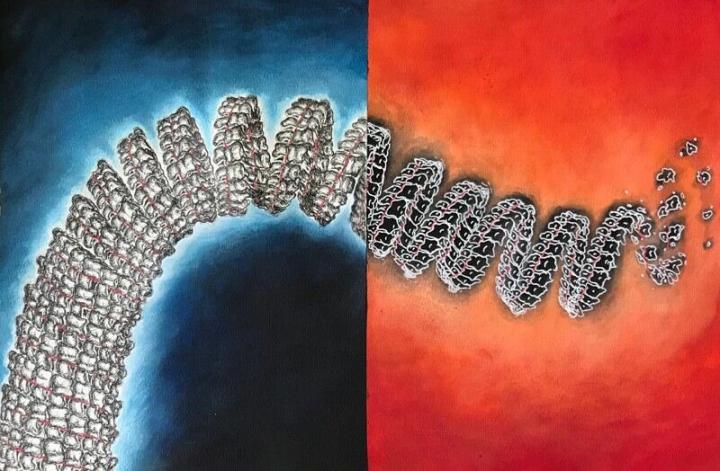Targeting the shell of the Ebola virus

A coiling protein 'shell,' called a nucleocapsid, shown here, surrounds Ebola's genetic material, which consists of single-strand RNA. University of Delaware researchers are simulating the way molecules of this nucleocapsid move and interact, atom by atom, to understand their functions and expose targets for anti-viral treatments.
Credit: Juan Perilla Laboratory
UD research team looking at ways to destabilize virus, knock it out with antivirals.
As the world grapples with the coronavirus (COVID-19) pandemic, another virus has been raging again in the Democratic Republic of the Congo in recent months: Ebola. Since the first terrifying outbreak in 2013, the Ebola virus has periodically emerged in Africa, causing horrific bleeding in its victims and, in many cases, death.
How can we battle these infectious agents that reproduce by hijacking cells and reprogramming them into virus-replicating machines? Science at the molecular level is critical to gaining the upper hand — research you’ll find underway in the laboratory of Professor Juan Perilla at the University of Delaware.
Perilla and his team of graduate and undergraduate students in UD’s Department of Chemistry and Biochemistry are using supercomputers to simulate the inner workings of Ebola, observing the way molecules move, atom by atom, to carry out their functions. In the team’s latest work, they reveal structural features of the virus’s coiled protein shell, or nucleocapsid, that may be promising therapeutic targets, more easily destabilized and knocked out by an antiviral treatment.
The research is highlighted in the Tuesday, Oct. 20 issue of the Journal of Chemical Physics, which is published by the American Institute of Physics, a federation of societies in the physical sciences representing more than 120,000 members.
“The Ebola nucleocapsid looks like a Slinky walking spring, whose neighboring rings are connected,” Perilla said. “We tried to find what factors control the stability of this spring in our computer simulations.”
The life cycle of Ebola is highly dependent on this coiled nucleocapsid, which surrounds the virus’s genetic material consisting of a single strand of ribonucleic acid (ssRNA). Nucleoproteins protect this RNA from being recognized by cellular defense mechanisms. Through interactions with different viral proteins, such as VP24 and VP30, these nucleoproteins form a minimal functional unit — a copy machine — for viral transcription and replication.
While nucleoproteins are important to the nucleocapsid’s stability, the team’s most surprising finding, Perilla said, is that in the absence of single-stranded RNA, the nucleocapsid quickly becomes disordered. But RNA alone is not sufficient to stabilize it. The team also observed charged ions binding to the nucleocapsid, which may reveal where other important cellular factors bind and stabilize the structure during the virus’s life cycle.
Perilla compared the team’s work to a search for molecular “knobs” that control the nucleocapsid’s stability like volume control knobs that can be turned up to hinder virus replication.
The UD team built two molecular dynamics systems of the Ebola nucleocapsid for their study. One included single-stranded RNA; the other contained only the nucleoprotein. The systems were then simulated using the Texas Advanced Computing Center’s Frontera supercomputer – the largest academic supercomputer in the world. The simulations took about two months to complete.
Graduate research assistant Chaoyi Xu ran the molecular simulations, while the entire team was involved in developing the analytical framework and conducting the analysis. Writing the manuscript was a learning experience for Xu and undergraduate research assistant Tanya Nesterova, who had not been directly involved in this work before. She also received training as a next-generation computational scientist with support from UD’s Undergraduate Research Scholars program and NSF’s XSEDE-EMPOWER program. The latter has allowed her to perform the highest-level research using the nation’s top supercomputers. Postdoctoral researcher Nidhi Katyal’s expertise also was essential to bringing the project to completion, Perilla said.
While a vaccine exists for Ebola, it must be kept extremely cold, which is difficult in remote African regions where outbreaks have occurred. Will the team’s work help advance new treatments?
“As basic scientists we are excited to understand the fundamental principles of Ebola,” Perilla said. “The nucleocapsid is the most abundant protein in the virus and it’s highly immunogenic — able to produce an immune response. Thus, our new findings may facilitate the development of new antiviral treatments.”
Currently, Perilla and Jodi Hadden-Perilla are using supercomputer simulations to study the novel coronavirus that causes COVID-19. Although the structures of the nucleocapsid in Ebola and COVID-19 share some similarities — both are rod-like helical protofilaments and both are involved in the replication, transcription and packing of viral genomes — that is where the similarities end.
“We now are refining the methodology we used for Ebola to examine SARS-CoV-2,” Perilla said.
All latest news from the category: Life Sciences and Chemistry
Articles and reports from the Life Sciences and chemistry area deal with applied and basic research into modern biology, chemistry and human medicine.
Valuable information can be found on a range of life sciences fields including bacteriology, biochemistry, bionics, bioinformatics, biophysics, biotechnology, genetics, geobotany, human biology, marine biology, microbiology, molecular biology, cellular biology, zoology, bioinorganic chemistry, microchemistry and environmental chemistry.
Newest articles

Hyperspectral imaging lidar system achieves remote plastic identification
New technology could remotely identify various types of plastics, offering a valuable tool for future monitoring and analysis of oceanic plastic pollution. Researchers have developed a new hyperspectral Raman imaging…

SwRI awarded $26 million to develop NOAA magnetometers
SW-MAG data will help NOAA predict, mitigate the effects of space weather. NASA and the National Oceanic and Atmospheric Administration (NOAA) recently awarded Southwest Research Institute a $26 million contract…

Protein that helps cancer cells dodge CAR T cell therapy
Discovery could lead to new treatments for blood cancer patients currently facing limited options. Scientists at City of Hope®, one of the largest and most advanced cancer research and treatment…



